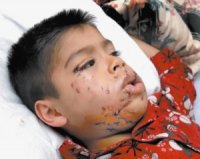NCRC is currently investigating 31 incidents in a dog population of over 78 million that occurred during 2011 that may qualify as dog bite-related fatalities.
News reports published in the moment usually refer to the dogs involved as “family” dogs, implying that these were dogs whose owners interacted with them on a regular basis in positive and humane ways. Later investigation shows that most of the dogs involved in these incidents were “resident” dogs - victims of isolation, and often abuse or neglect. NCRC's preliminary findings for 2011 are consistent with findings concerning the dog bite-related fatalities of years past. In 2010, the news media initially described the dogs in 29 of 33 (88%) dog bite-related fatalities as “family” pets, but investigations disclose that only 7 (21%) were family pets.
The news media regularly describe dogs as members of specific breeds. Yet, NCRC’s investigations over the years show that a majority of the breed descriptors assigned by the news media cannot be documented or otherwise considered reasonable (through pedigree, DNA or otherwise). For example, NCRC investigations of the dog bite-related fatalities in 2010 showed that in only eleven of the cases could the breed descriptors assigned to the dogs be documented, or otherwise considered reasonable. Eight different kinds of dogs were identified in those eleven incidents. The breed composition of all the other dogs was indeterminate, whatever the news media reported about them. In fact, in three cases in 2010, news stories identified dogs and attributed breeds to those dogs that detectives later determined were NOT the dogs involved in the incident. The dog(s) responsible were never identified or captured.
News outlets, having moved on to other, pressing issues, never corrected this.
There is no scientific evidence that one kind of dog is more likely to injure a human being than another kind of dog. There is no evidence that, absent circumstances specifically associated with mating or maternal protectiveness, a dog being intact should be understood as a cause of aggressive behavior
toward human beings. And for every “resident” dog that injured a human being, multitudes sadly similarly kept injured no one. Yet, as NCRC’s mission is to preserve the human-canine bond, these rare tragedies serve as a reminder
that all dog owners have an unequivocal responsibility for the humane care (including proper diet, veterinary care, socialization and training), custody (including licensing and micro-chipping), and control of their dogs.









